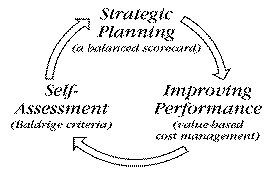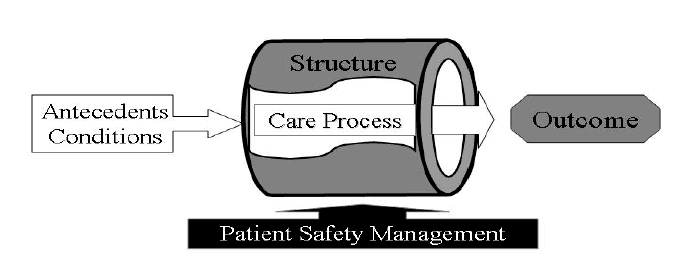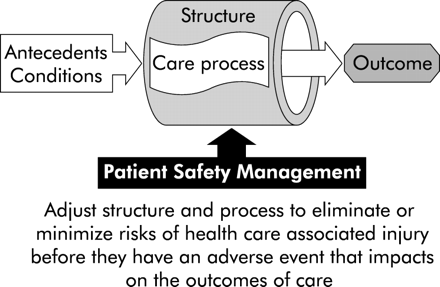Avedis Donabedian proposed a model for assessing health care quality based on structures, processes and outcomes (Mendez, 1999). “Donabedian defines structure as the environment in which health care is provided, process as the method by which health care is provided and outcome as the consequence of the health care provided” (Mendez, 1999). According to Donabedian’s model, processes can be restrained by the structures in which they operate (Mendez, 1999).
Donabedian’s structure-process-outcome model has been used as a guideline for examining health services and assessing patient outcomes (Medical Teamwork and Patient Safety, 2010). It is one of the most effective methods of ensuring patient satisfaction. According to Donabedian, structure encompasses both the physical and organizational aspects involved in the provision of healthcare (Medical Teamwork and Patient Safety, 2010). Donabedian describes the process as the treatment or service being provided to the patient. Finally, outcomes are referred to as the results of the treatment (Medical Teamwork and Patient Safety, 2010). A positive outcome reflects on the good standards of patient care.
According to Mendez (1999), an effective measurement system uses its resources to improve the performance of any given medical institution. A measurement system ensures that the medical staff works effectively. Managers are tasked with the responsibility of choosing appropriate structures. These structures are used to create a work environment that functions smoothly. Mendez (1999) suggests that measures should be selected after a healthcare manager decides how they can be applied. A patient’s satisfaction depends on the quality of healthcare he or she is receiving. Mendez (1999) describes the model in the table below:

Many medical practitioners have referred to this model on more than one occasion. Donabedian’s model has many applications. It can be used to save on medical expenses. It can also be used to ensure client satisfaction. Donabedian’s model protects an institution’s staff from legal problems. Such problems are usually caused by angry clients. Incompetence among staff members may also be one of the rising concerns within a medical institution.
All members of a medical institution should be interviewed prior to their employment. Screenings should therefore be done on a regular basis. Periodic interviews are necessary in order to ensure adequate performance among the members of a particular institution. Donabedian’s approach caters for such situations.
Outcomes are the final results of any given situation. The situation should be medical in nature. If an institution meets its documented expectations, then the outcome is said to be positive. If patients express dissatisfaction on a regular basis, then the outcome is said to be negative. The medical staff’s performance is measured on the basis of patient satisfaction. A hospital that enforces good conduct and human decency is likely to get a good review from its clients.
Westaway, Rheeder, Van Zyl and Seager (2003) conducted a study based on Donabedian’s structure, process, and outcome model. The study was conducted to point out the major components of patient satisfaction in diabetic patients (Westaway et al., 2003).
A patient satisfaction scale was used as the basis of measurement and two factors that covered 71.6% of the difference, were extracted (Westaway et al., 2003). Westaway et al. (2003) concluded that the findings supported Donabedian’s model. According to Westaway et al. (2003), they demonstrated that attributes of providers and settings are some of the major components of patient satisfaction.
Such an experiment can be conducted to certify the effectiveness of any given model. Donabedian’s approach has been used on various occasions to meet the never ending demands of patients. It can be used to stop the spread of diseases within a hospital. This is just one of the many applications that Donabedian’s model has.
“Although healthier patients are generally more satisfied with their care than less healthy patients, there is a lack of clarity on the relationship between health status and the various components of patient satisfaction” (Westaway et al., 2003). It is therefore important for a doctor to explain everything to his patient. Donabedian’s model proposes open dialogue between both parties.
Donabedian’s model focuses mainly on patient safety. It provides an intricate outline that describes patient safety and points out the risks and hazards that may have the potential to cause unnecessary harm to an institution’s patients (Medical Teamwork and Patient Safety, 2010). Patients can be described as the driving force behind all medical institutions. An institution that prides itself with patient care is therefore supposed to ensure that its clients are taken care of.
Institutions should therefore act responsibly when they are faced with such situations. Without this specified structure, an organization is likely to fall apart. An article by Medical Teamwork and Patient Safety (2010) states the following:
“The Agency for Research Healthcare Quality cites Coyle and Battles as the modifiers of the Donabedian model. Coyle and Battles modified Donabedian’s model to include other vital conditions that can affect the outcomes of particular methods of treatment. Some people do not respond positively to change. It is therefore important to explain the need for new strategies to all the parties that may be affected. Improved patient outcomes are exceptionally important”.
Some scholars define customer satisfaction as the bottom line of any business venture. In most cases, this is true. Customers are more likely to support an institution if the service provided is exceptional. The customer approach has been outlined by Medical Teamwork and Public Safety (2010) in the following figure:

An article from Medical Teamwork and Public Safety (2010) states that patient safety is one of the most important aspects of medical care. It is therefore important for any medical institution to ensure the wellbeing of its clients. A patient can be described as the market that holds the finances of any given healthcare system. Patients pay for medical insurance. They are therefore entitled to proper treatment whenever the need for such medical care arises.
Medical Teamwork and Public Safety (2010) acknowledges a patient’s diversity in relation to the quality of healthcare that he or she may be receiving. It is important to note that certain social or cultural factors may affect the type of treatment used within a given institution (Medical Teamwork and Public Safety, 2010). Some patients may come from particular religions or ethnicities that do not permit certain forms of treatment. Medical institutions should therefore be equipped to deal with such situations.
The medical fraternity has been known to support such innovations (Medical Teamwork and Public Safety, 2010). According to McCabe (2010), most scholars trying to come up with systems that identify quality medical care base their conclusions on the outcome. This is a difficult process. This is because the outcome of a given situation depends on several interrelated factors. “The Donabedian model has been universally accepted as the basis for much of the work addressing the quality and outcomes of healthcare” (McCabe, 2010). Unlike many other pre-existing models, it can be applied on a more personal level. There should be a relative balance between all the dimensions of patient care in order to improve the total quality of care in a given system (McCabe, 2010). Donabedian’s model acts as a guide for many medical institutions.
Patient safety has become a major concern throughout the world (Battles and Lilford, 2003). According to Battles et al. (2003), major patient safety research efforts have been launched. Medical insurance has become one of mankind’s basic needs. All parties responsible for an individual’s health should work as a team. Accidents are bound to happen. Mistakes are likely to be made. Structures should therefore be put in place to ensure that the right parties are held responsible in case something goes wrong. Safety measures should act as guidelines. They should be enforced.
According to Battles et al. (2003), not all methods are effective. Professional integrity and human compassion should go hand in hand. It is more appropriate to institute several approaches that deal with patient satisfaction. The quality of healthcare can be improved if the right strategies are put in place. Donabedian’s model proposes a more compassionate approach to medical care. The model ensures that a patient’s needs are met. It sets standards that rival many other healthcare strategies. The Battle and Lilford (2003) approach is more specific, as seen in the diagram below:

Research approaches associated with health services have raised a great deal of concern (Battles et al., 2003). Patients do not usually understand the need for such research approaches. They feel entitled to proper medical care despite the barriers that it presents. Some patients may feel neglected if their needs are not met. They may have high expectations that some institutions cannot cater for. Some of these expectations may seem petty and trivial. Some have even been known to take legal action against institutions that have failed to meet their demands. Research alone may not be able to meet the demands of patient safety (Battles et al., 2003). According to Battles et al. (2003), the methods used for identifying risks and hazards are different from those used for coming up with solutions. This is a delicate process and must therefore be handled with care. All hospitals are therefore entitled to have a legal department. This department deals with all matters pertaining to medical law.
Patient safety includes the use of information technology (Battles et al., 2003). This can be used to avoid the common mistakes that healthcare workers make (Battles et al., 2003). Patient records should be stored in a digital format. This process ensures that all medical data is easily accessible. These records may contain a patient’s medical history. A person who has been diagnosed with a particular illness can greatly benefit from this information.
Donabedian’s model is still applicable today. The strategies that the model applies are linked directly to the health of the patients in question. It is a human-oriented approach. It bases its success on the outcome of a given procedure. Medical institutions that use Donabedian’s model may be forced to make financial sacrifices. The same institutions can also save a lot of money by applying the concepts that the model proposes. Many people cannot afford proper medical care. Donabedian’s model ensures that all parties are treated equally. The model is effective because it proposes adequate medical care, regardless of a person’s economic background. The model also advocates for personal responsibility. This ensures that patients receive proper medical care. It also helps health institutions to avoid legal action from disgruntled clients. Donabedian’s model is probably one of the best strategic approaches because it caters for all parties within the medical fraternity.
Reference List
Battles, J.B. and Lilford, R.J. (2003). Quality and Safely. In Healthcare Organizing Patient Safety Research to Identify Risks and Hazards. Web.
McCabe, S. (2010). From NLM Gateway. The Problem with Structure-Process-Outcome: Challenging the Donabedian Notion of Quality of Care. Academy for Health Services Research and Health Policy. Web.
Medical Teamwork and Patient Safety (2010). Medical Team Training. Agency for Research Healthcare Quality. The Donabedian Model of Patient Safety. Web.
Mendez, K.C. (1999). Performance Measurement in Health Care. Web.
Westaway, M.S., Rheeder, P., Van Zyl, D.G. and Seager, J.R. (2003). Interpersonal and Organizational dimensions of patient satisfaction: The moderating effects of health status. International Journal for Quality in Health Care. International Society for Quality in Health Care. Web.